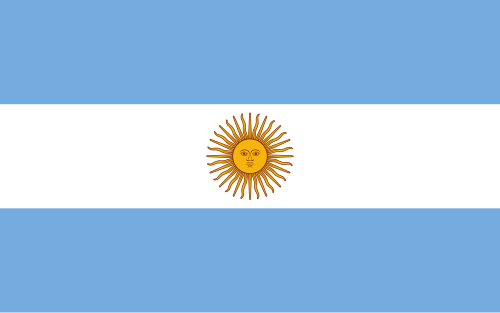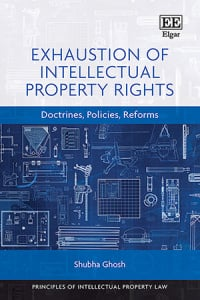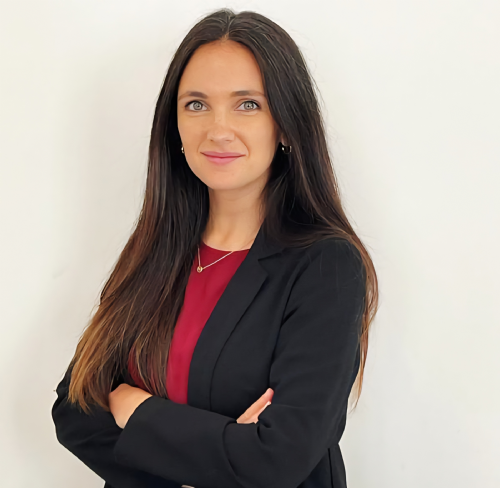Now in its twelfth year, Class 46 is dedicated to European trade mark law and practice. This weblog is written by a team of enthusiasts who want to spread the word and share their thoughts with others.
Click here subscribe for free.
Who we all are...
Argentina and US advance trade framework
 Argentina and the United States announced a framework on 13 November 2025 to deepen bilateral trade and investment ties, signalling a potential reset of Argentina’s IP regime after more than a decade of restrictive pharmaceutical patent practice. Dámaso Pardo, a member of the MARQUES International Trade Mark Law and Practice Team, explains more.
Argentina and the United States announced a framework on 13 November 2025 to deepen bilateral trade and investment ties, signalling a potential reset of Argentina’s IP regime after more than a decade of restrictive pharmaceutical patent practice. Dámaso Pardo, a member of the MARQUES International Trade Mark Law and Practice Team, explains more.
The joint statement, issued under the countries’ Trade and Investment Framework Agreement, commits both sides to foster a “transparent and rules-based environment for commerce and innovation” and singles out IP as a priority area for reform.
In the statement, the United States noted Argentina’s recent enforcement actions against a major regional market for counterfeit goods and highlighted commitments by Argentina to tackle structural concerns cited in the 2025 Special 301 report.
Those include patentability criteria, patent backlog and geographical indications, alongside broader alignment of Argentina’s IP framework with international standards.
The Milei administration in Buenos Aires would be forced to modify certain regulations and ratify IP treaties, putting IP at the centre of ongoing talks, focusing on two headline measures: repealing a 2012 Joint Resolution that tightened the examination of pharmaceutical patents and advancing ratification of key international IP treaties including the Patent Cooperation Treaty (PCT), the Madrid Protocol, and the Hague Agreement.
2012 Joint Resolution
At the heart of the policy debate is the 2012 Joint Resolution (MI 118/12, MS 546/12, INPI 107/12), adopted during the administration of Cristina Fernández de Kirchner.
That measure introduced restrictive examination guidelines for chemical-pharmaceutical inventions at the National Institute of Industrial Property (INPI), curbing what innovators describe as routine avenues of protection for follow-on improvements. The guidelines have sharply limited patentability for new forms of known substances, dosing regimens, combinations lacking demonstrated synergy, and second medical use claims, among others, driving lower allowance rates, lengthier prosecution, and narrower claim scopes.
Research-based pharmaceutical companies have long argued that the framework deters investment in high-risk R&D and places Argentina at a disadvantage relative to jurisdictions applying standards closer to the European Patent Convention or the United States.
Domestic generic manufacturers, represented by industry groups such as CILFA, have historically supported the tighter criteria, framing them as necessary to prevent “evergreening” and protect public health. Litigation brought by the Argentine Chamber of Medical Specialties (CAEME) and the Biotechnology Chamber (CAB) to overturn the 2012 regime has thus far failed to dislodge it.
In a first-instance ruling on 9 October 2025, Federal Civil and Commercial Court No 1 upheld the validity of the 2012 guidelines and related administrative measures, finding them consistent with Argentina’s Patent Law and flexibilities under the TRIPS Agreement. The court emphasised the guidelines’ status as internal instructions to examiners rather than new legal requirements, while noting that the executive retains authority to repeal the resolution. Appeals remain possible to higher courts.
Multilateral IP systems
Parallel to domestic policy shifts, Argentina is moving to integrate with multilateral IP systems long favoured by its trading partners. While the Senate approved the PCT in 1998, final ratification still requires approval by the Chamber of Deputies.
The Argentine government will have to complete PCT ratification before the end of 2025 and then adopt the Madrid Protocol for trade marks and the Hague Agreement for industrial designs as well as other international treaties before the end of the Milei mandate in 2027. If enacted, these steps would streamline cross-border protection for patents, brands, and designs and bring Argentina into closer alignment with the practices of major markets.
Industry observers say the combined effect of repealing the 2012 pharmaceutical guidelines and adopting international registration systems could materially alter Argentina’s innovation landscape.
Although details of any revised patentability criteria have not been released, practitioners expect either a full repeal of the 2012 resolution or a negotiated replacement that eases current restrictions while addressing domestic stakeholders’ concerns.
Procedurally, faster pathways may also gain traction. INPI’s existing accelerated examination mechanism under Resolution P-56/2016 allows applicants to leverage a granted foreign patent – subject to constraints on claim scope, prior art, and patentable subject matter – with a 60-day decision window once conditions are met. In a reformed environment, companies could see patent grant timelines fall from the current eight to ten years to as few as four years in straightforward cases.
Any shift is likely to reverberate across Argentina’s pharmaceutical sector. Strengthened protection for incremental innovations could extend exclusivities around core compounds, alter lifecycle management strategies, and influence the timing of generic entry. Generic manufacturers may face a tighter window to launch variants and follow-on formulations, even as data requirements and evidentiary standards continue to frame examination outcomes.
For global rights holders, alignment with the PCT, Madrid, and Hague systems would reduce administrative friction and facilitate coordinated filing strategies across markets.
The path ahead remains tied to political and legislative calendars. With a new composition in Congress after 10 December 2025, government officials and industry stakeholders are preparing for consequential debates over the contours of Argentina’s IP policy.
While further court proceedings may continue in parallel, the executive branch retains latitude to unwind or replace the 2012 guidelines.
For now, the joint US-Argentina framework marks the clearest signal yet that Buenos Aires intends to recalibrate its IP rules toward international norms, setting the stage for a new chapter in trade, investment, and innovation policy.
Dámaso Pardo is a partner of Bruchou & Funes De Rioja in Argentina and a member of the MARQUES International Trade Mark Law and Practice Team
Posted by: Blog Administrator @ 19.21Tags: Argentina, US, patent,


 Sharing on Social Media? Use the link below...
Sharing on Social Media? Use the link below...Perm-A-Link: https://www.marques.org/blogs/class46?XID=BHA5403
WIPO survey shows increased trust and awareness in IP
 WIPO has published WIPO Pulse 2025, which is based on a survey of 35,500 respondents aged 18 to 65 in 74 countries.
WIPO has published WIPO Pulse 2025, which is based on a survey of 35,500 respondents aged 18 to 65 in 74 countries.
The survey found that global recognition of IP’s critical role in protecting innovation and creativity and IP understanding across all categories of IP have increased since the inaugural survey of 2023.
The key findings of WIPO Pulse 2025 are:
- IP awareness has increased all categories, with public awareness of trade marks and copyright increasing from 30% to 36% and from 38% to 40% respectively. There has been substantial progress in the Asia-Pacific region: awareness of geographical indications has increased from 26% to 35%, copyright from 32% to 40% and trade marks form 26% to 34%
- Progress among women and youth: In the Asia-Pacific, women’s awareness increased across all five IP rights measured: copyright awareness rose from 31% to 40% and trade mark awareness from 26% to 34%. Youth awareness increased in Asia-Pacific and western Europe, but declined in Latin America, the Caribbean and eastern Europe.
- Strong trust in IP rights: when asked to rate their agreement with key IP attributes, respondents scored on average 4 on a scale of 1 to 5.
- Confidence in IP’s role in the economy: Positive perceptions of the impact of IP on the economy remains stable at 64%
WIPO Director General Daren Tang said in a statement: “The good news from our survey is that IP is increasingly winning hearts and minds all over the world. Public awareness of IP has grown and attitudes towards IP has become more positive. But there is work ahead – there are still disparities in IP awareness among certain age groups towards awareness and certain types of IP remain relatively unknown.”
The report runs to 48 pages and can be viewed and downloaded on WIPO’s website here.
Picture shows the cover of the report
Posted by: Blog Administrator @ 12.09Tags: WIPO Pulse 2025, IP awareness,


 Sharing on Social Media? Use the link below...
Sharing on Social Media? Use the link below...Perm-A-Link: https://www.marques.org/blogs/class46?XID=BHA5402
Guidelines on fluid trade marks
 |
| The Google Doodle is an example of a fluid trade mark |
The MARQUES Brands and Marketing Team has published a set of guidelines for companies on the use of fluid trade marks.
Fluid trade marks are a creative way to engage audiences by evolving a brand’s visual identity while preserving its core recognizability. Variations may include changes in colour, form or animation.
While fluid trade marks offer flexibility and relevance for modern brands, legal and strategic safeguards are essential to prevent loss of distinctiveness or enforcement challenges.
The 17 guidelines cover: core identity protection, legal risk management, strategic and creative use, enforcement and control, digital and technological considerations, and long-term oversight.
The document can be downloaded from the Team’s page on the MARQUES website (MARQUES log-in required).
The guidelines are written by Farah Molino, Rocio Fernandez-Bujarrabal, Djura Mijatovic and Flavia M Murad-Schaal, who are all members of the Team.
Picture from the Google Doodle library.
Posted by: Blog Administrator @ 12.54Tags: Fluid trade marks, brands and marketing, ,


 Sharing on Social Media? Use the link below...
Sharing on Social Media? Use the link below...Perm-A-Link: https://www.marques.org/blogs/class46?XID=BHA5401
Book review: Exhaustion of Intellectual Property Rights
 Charlotte Duly of the MARQUES Education Team reviews “Exhaustion of Intellectual Property Rights” by Professor Shubha Ghosh (published by Edward Elgar Publishing, priced £95 for the hardback and available here).
Charlotte Duly of the MARQUES Education Team reviews “Exhaustion of Intellectual Property Rights” by Professor Shubha Ghosh (published by Edward Elgar Publishing, priced £95 for the hardback and available here).
This book reviews the principle of exhaustion of IP rights on a global basis, including the approach in the USA, EU and other territories. The book splits the various IP rights into separate chapters, looking at how exhaustion is applied in the fields of patents, copyright, trade marks and trade secrets.
Exhaustion is a hot topic in the United Kingdom following the departure from the EU (Brexit).
Generally, the EU principle of exhaustion means that once a product has been placed on the market in an EU member state with the rights holder’s consent, the rights holder cannot use their IP rights to prevent the resale or free movement within the EU. Following Brexit, the UK had to consider their position regarding exhaustion and opted for a unique UK+ regime, which the UK government confirmed would be maintained earlier this year.
The UK’s position essentially ensures that IP rights are exhausted in the UK when a good is placed on the market in either the UK or the European Economic Area (EEA). However, this is not reciprocated and now the UK is outside the of the EU it does not have the benefit of the EU exhaustion principle, meaning the flow of goods from the UK to the EU could be restricted by IP rights.
Globally, the position is, unsurprisingly, not uniform and this book offers a clear and comprehensive explanation of how exhaustion applies to the various IP rights across a number of territories.
In recent years, key trends and issues have emerged across sectors, in particular involving the environment and advances in technology. This book contains a chapter dedicated to upcycling and renewal and considers how exhaustion may apply beyond the first-sale doctrine to allow for reuse.
Digital exhaustion is also discussed and is likely to be an ever-growing topic of interest across the globe. Whilst technological measures may be used in the digital sphere to make the resale or reuse of rights difficult or impossible, as there are further advances in technology the opportunities to exploit rights will evolve and this chapter provides food for thought.
This book is thought provoking and will be embraced by students and IP scholars. It is also a fascinating source of information for those working in the IP field, such as lawyers and rights holders, to consider the boundaries and evolution of exhaustion.
The picture shows the cover of 'Exhaustion of Intellectual Property Rights'
Posted by: Blog Administrator @ 11.10Tags: Book review, Education Team, exhaustion,


 Sharing on Social Media? Use the link below...
Sharing on Social Media? Use the link below...Perm-A-Link: https://www.marques.org/blogs/class46?XID=BHA5400
Luxury, law and distribution: the Chanel case in Italy
In a guest post for Class 46, Alice Fratti discusses a recent case that illustrates how law and marketing can protect brand value and the customer experience for everyone enjoying the allure of luxury:
A recent decision by the Court of Milan’s illustrates how the control of distribution channels is crucial in preserving the prestige of luxury goods. The ruling reinforces the importance for brand owners of protecting selective distribution, and for retailers it serves as a warning that cutting corners on brand presentation can potentially have serious legal and reputational consequences.
We are reminded by this case that luxury is crucially about experience, not just products. It is about the presentation of a product and the story that unfolds throughout the customer’s retail experience. Selective distribution is therefore much more than a legal safeguard; it is an essential component of luxury brand management.
The case
In an order dated 3 March 2025 which was confirmed on appeal on 9 June 2025, the IP Chamber within the Court of Milan ruled in favour of Chanel against the companies operating Acqua & Sapone, a leading Italian retail chain in the mass-market sector, which is engaged in the sale and distribution of personal care, beauty, hygiene, and household cleaning products.
Acqua & Sapone manages a widespread network of retail outlets throughout Italy, offering branded consumer goods to the general public at competitive prices.
The evidence presented in the case showed that the products were sold in a mass-market environment, within the same premises where a wide variety of goods from different product categories – none possessing any aura of luxury – were also sold, even if displayed in separate areas within the store. In particular, the products were kept in drawers rather than displayed on shelves.
The Court upheld Chanel’s request and prohibited the sale and advertising of Chanel perfumes outside the authorised selective distribution network. The Court found that the specific sales methods adopted by Acqua & Sapone impaired the brand’s aura of luxury, thereby justifying a derogation from the principle of trade mark exhaustion.
General principles of selective distribution
Chanel’s commercial strategy, similar to other luxury brands, is based on an accurate system of selective distribution. Article 1(g) of Regulation (EU) 720/2022 (VBER) defines selective distribution as a system in which the supplier agrees to sell goods or services only to distributors selected on the basis of specified criteria, and such distributors agree not to sell those goods or services to unauthorised resellers.
This system ensures not only quality and professionalism in the sales process but also a shopping experience aligned with consumer expectations. The Court of Justice of the European Union (CJEU) has repeatedly emphasised, most notably in the Coty case (Case C-230/16), that the quality of luxury goods derives not only from their material characteristics but also from the prestige and aura of exclusivity that surround them, from the experience of product selection to the particular packaging at the end of the customer’s sale.
Trade mark exhaustion and its exceptions
The Chanel case directly touches upon the principle of trade mark exhaustion. Article 5(1) of the Italian Industrial Property Code (c.p.i.) provides that the trade mark owner cannot oppose the further commercialisation of a product once it has been placed on the market within the European Economic Area by the owner or with their consent. However, Article 5(2) introduces an exception: the owner may object to further commercialisation if legitimate reasons exist.
Jurisprudence and legal doctrine confirm that selling luxury products outside the authorised network, in conditions detrimental to the brand’s image, represents precisely such a scenario. However, recognition of this exception requires a precise and specific assessment of the sales methods adopted by the unauthorised reseller, with the need to demonstrate that these practices harm the prestige and exclusivity of luxury products.
Final considerations
The Chanel litigation demonstrates how law and marketing intersect in the defence of luxury goods. Selective distribution is not merely a legal instrument; it is an essential component of the brand’s consistency in the market space and one that is worth protecting.
Alice is counsel at Trevisan & Cuonzo in Italy, which represented Chanel in this case and is a member of MARQUES
Posted by: Blog Administrator @ 11.37Tags: Selective distribution, Chanel,


 Sharing on Social Media? Use the link below...
Sharing on Social Media? Use the link below...Perm-A-Link: https://www.marques.org/blogs/class46?XID=BHA5399
UK officials seize more than 3,600 fake vehicle parts
 An operation by South Gloucestershire Trading Standards in the United Kingdom has removed more than 3,600 counterfeit branded car parts, with an estimated value of more than £100,000 (€113,000).
An operation by South Gloucestershire Trading Standards in the United Kingdom has removed more than 3,600 counterfeit branded car parts, with an estimated value of more than £100,000 (€113,000).
The UK IPO supported the action, which involved enforcement teams from eight car manufacturers.
The seized items included fake spark plugs, oil filters, air filters, fuel filters, windscreen wipers and sensors. Also found were counterfeit parts in plain packaging and sheets of unused counterfeit labels.
The seizure follows the arrest of three people in east London over the sale of counterfeit airbags in September last year.
According to a recent UK IPO survey, one in six motorists bought a counterfeit part in the previous 12 months alone. The most commonly bought counterfeit parts were car batteries, tyres/wheels, brake pads/discs and airbags.
In a notice published by the UK IPO last week, the Office’s Deputy Director of Enforcement said: “These fake parts bypass safety tests and are often made with vastly inferior materials, putting them at serious risk of failure with potentially devastating results. This latest seizure demonstrates that criminals are continuing to exploit the use of legitimate self-storage facilities across the UK to store counterfeit goods.”
Picture from UK IPO website
Posted by: Blog Administrator @ 11.17Tags: UK IPO, car parts, counterfeits,


 Sharing on Social Media? Use the link below...
Sharing on Social Media? Use the link below...Perm-A-Link: https://www.marques.org/blogs/class46?XID=BHA5398
"An incredibly encriching experience" - first timer on the Annual Conference
 |
| Sara De Toledo |
The Class 46 blog is pleased to publish the first article in a new series by members of the Education Team, in which they provide a fresh perspective on MARQUES and its members.
For this article, Education Team member Graeme Murray asked Sara De Toledo, fellow Team member and first time attendee at this year’s Annual Conference, to discuss her experience in The Hague, tips for first time attendees, and her plans for future involvement with the organisation:
This was your first MARQUES Annual Conference: how did you hear about MARQUES and why did you decide to attend this year?
First of all, I would like to thank MARQUES and, in particular, the Education Team for giving me the opportunity to share my experience. This was my first time attending the MARQUES Annual Conference, and it truly exceeded my expectations.
I first heard about MARQUES several years ago when I began specialising in intellectual property. A colleague mentioned the association and told me which members of our firm would be attending the MARQUES Annual Conference that year. A few months later, another colleague who had just joined as an intern received the Lewis Gaze Memorial Scholarship from MARQUES for their essay on trademarks, which included an invitation to attend that year’s and the following year’s Conference.
Since then, MARQUES has been a professional reference point and a key source of knowledge for me. This year, my firm kindly gave me the privilege of representing them within the association, so that is why I attended the Conference for the first time.
How was your experience of the Conference as a first timer?
| "It was inspiring to meet people with similar interests, but also those with different perspectives." |
From the moment I arrived in The Hague, my experience was excellent. The Conference is extremely well organised. Even before travelling, participants have access to all the relevant information (accommodation, transport, the venue, and more) which makes the experience very smooth.
The fact that MARQUES arranges the entire schedule, including sessions, lunches, dinners, and social activities, is a huge advantage, as it allows attendees to focus on what really matters: participating in the sessions and networking with colleagues from across the profession.
I particularly enjoyed the presentations, not only because of the topics covered, but also because of the impressive calibre of the speakers. It was inspiring to meet people with similar interests, but also those with different perspectives. Overall, it was an incredibly enriching experience.
What did you enjoy most about this year’s conference?
Without a doubt, the sessions and the evening event at Madurodam.
Madurodam is a park featuring miniature models of the most famous landmarks in the Netherlands, a unique and fascinating venue for a social evening. The park was closed exclusively for MARQUES attendees, who had the opportunity to explore it while enjoying a fun, themed night in great company. The variety of international cuisine, paired with good beer and lively conversation, made it truly unforgettable.
You have also joined the Education Team; what attracted you to the Team?
| "Joining the Education Team gives me the opportunity to collaborate with educators and students from various universities and to help develop educational resources." |
I wanted to get more deeply involved in MARQUES and contribute actively to the association’s work. The Education Team’s main objectives (managing the Lewis Gaze Memorial Scholarship, developing educational materials, organising seminars and workshops, and leading research and development projects) align perfectly with my own professional interests.
For several years, I have been committed to teaching as a trademark law lecturer in the Master’s in Intellectual Property and New Technologies at the Instituto Superior de Derecho y Economía (ISDE). I enjoy staying in touch with younger generations and serving as a bridge between academia and the professional world. Joining the Education Team gives me the opportunity to collaborate with educators and students from various universities and to help develop educational resources.
How do you intend to be involved in the general activities of the Education Team?
First and foremost, by attending the annual MARQUES meetings and the regular Committee sessions, which I believe are essential.
I have also volunteered to act as an additional liaison between universities and the association, reaching out to scholarship recipients to help build connections between students and MARQUES professionals.
MARQUES is an association where every professional has a place. However, young professionals can sometimes feel a little overwhelmed in such a highly experienced environment. I would like to help promote initiatives aimed at this group and encourage their active participation in the association.
I also look forward to contributing to the preparation of articles on relevant topics and the development of educational materials.
This was also the first time leaving your child, how did you find balancing conference and that milestone?
Thank you for asking. Yes, I have a baby, and attending the conference was a personal milestone for me, as it was the first time I had been apart from her for several days. It’s a challenge that many first-time parents face and finding that balance between professional and personal life is so important.
Having the support of one’s partner, family, or close circle is key. In my case, my husband fully understands how important my career and professional development are to me, and he is as involved as I am in raising our daughter. His support allowed me to focus fully on the conference and truly enjoy the experience.
Were there any sessions that really widened your knowledge or particularly interested you this year?
I found all the sessions very interesting, but one that particularly stood out was Brands in International Trade. It offered valuable insights into the challenges companies face today due to the rise of counterfeit goods and the growing second-hand market and how these developments impact brand owners’ defence strategies and action plans.
What tips would you give to future first time MARQUES attendees?
|
"MARQUES is one of the most prestigious IP conferences, bringing together top professionals from around the world, so attending the sessions is always a highly rewarding experience." |
First, I would recommend planning the trip well in advance and keeping an eye on all the information provided by the association whether via email or on the MARQUES website, to make the most of the experience.
I would also suggest familiarising yourself with other attendees ahead of time to identify people you might like to meet for coffee, lunch, or dinner, and even reaching out before the event to arrange a meeting during the Conference.
Go with an open mind, ready to meet new people and exchange ideas. And, most importantly, relax and enjoy every part of the programme. MARQUES is one of the most prestigious IP conferences, bringing together top professionals from around the world, so attending the sessions is always a highly rewarding experience.
Do you plan on attending next year’s conference in Lisbon?
Absolutely! I plan to attend all the Annual Conferences and hope to become an active and contributing member of the association.
I love the idea of discovering a different city each September, It’s a wonderful attraction for members. Attending every year also helps keep up with legislative and case law developments, strengthen professional relationships, and, who knows, perhaps one day connect with every member of MARQUES!
Posted by: Blog Administrator @ 17.26Tags: Education Team, Sara De Toledo,


 Sharing on Social Media? Use the link below...
Sharing on Social Media? Use the link below...Perm-A-Link: https://www.marques.org/blogs/class46?XID=BHA5397

